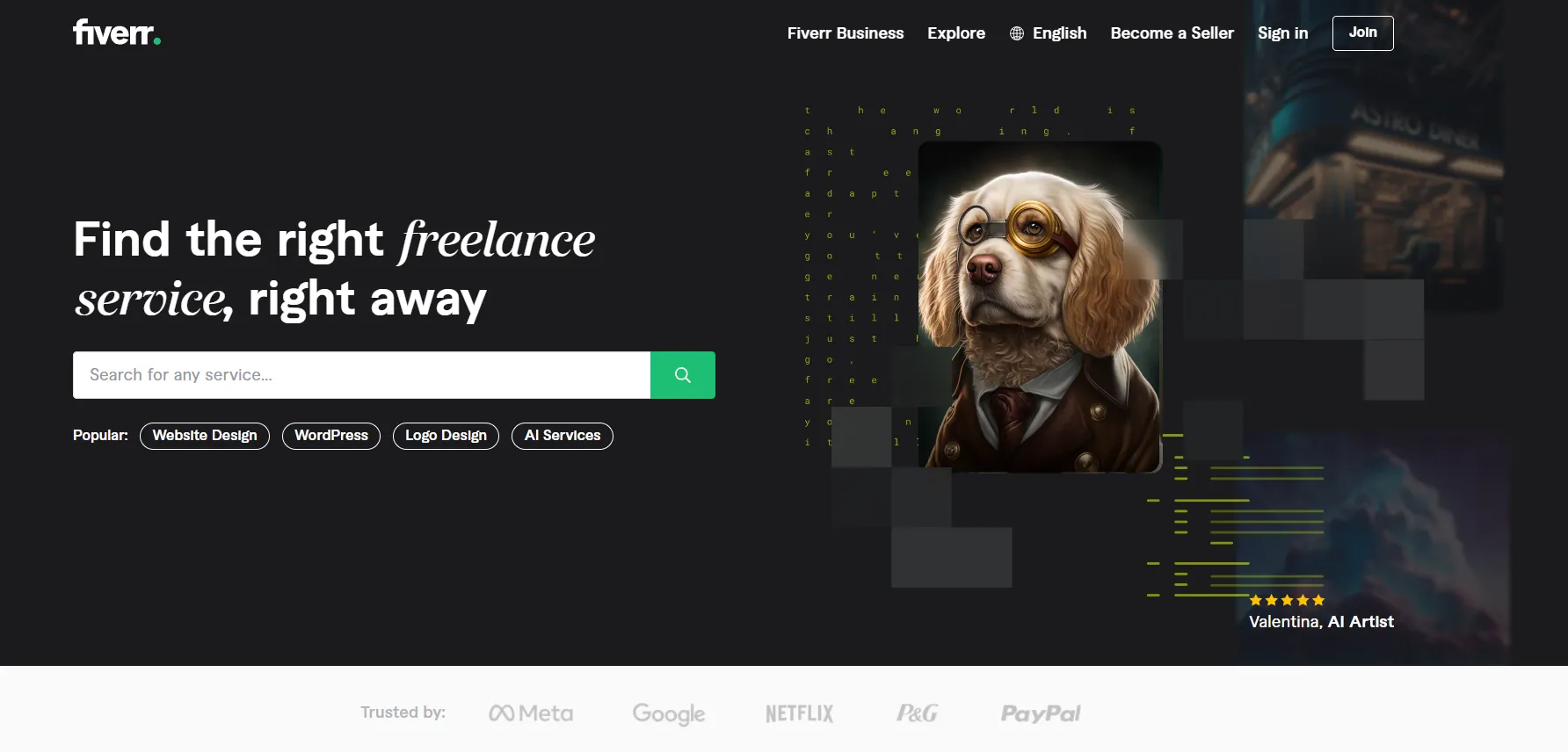Ah, Fiverr! Once the go-to platform for freelancers and clients looking to connect over a myriad of services. It revolutionized the gig economy, allowing people to sell their skills and services at an accessible price point. But in recent years, there have been significant changes, challenges, and even controversies surrounding it. So, what really happened to Fiverr? In this post, we’ll dive deep into the platform’s evolution, its ups and downs, and the current state of affairs. Buckle up, it’s going to be an enlightening journey!
The Rise of Fiverr: A Brief History

The story of Fiverr began in 2010, when co-founders Micha Kaufman and Shai Wininger launched a platform that aimed to “change how the world works together.” Their vision was simple yet revolutionary: to create a marketplace where anyone could offer and buy services starting at just $5. Here’s a little breakdown of Fiverr’s trajectory:
- 2010: The Launch - Fiverr opened its virtual doors to the public, presenting a user-friendly interface where freelancers could list their gigs.
- 2012: Growth Explosion - The platform gained undeniable traction, reaching 1 million transactions. Its unique concept attracted diverse talents—from graphic designers to voice-over artists, all eager to showcase their skills.
- 2013: Expansion of Services - Fiverr began broadening its offerings, enabling freelancers to sell gigs at different price points, thus allowing for more complex services.
- 2014: Marketing Innovations - With the introduction of video intros and better SEO optimization for gigs, Fiverr enhanced user experience, making it easier for clients to find the right talent.
- 2019: IPO and Market Penetration - Fiverr went public with an IPO, signaling confidence in its business model. The hype attracted a new wave of freelancers and clients alike.
Throughout its rise, Fiverr maintained its commitment to accessibility and affordability. However, as competition grew and the gig economy shifted, the platform faced its fair share of challenges and criticism. What exactly unfolded next? Stay tuned as we explore the tumultuous journey that followed!
Also Read This: Top Fiverr Sellers for Virtual Assistance in 2024
Key Challenges Faced by Fiverr

Since its inception, Fiverr has navigated a series of challenges that have tested its business model and operational capabilities. Some of the most notable challenges include:
- Increased Competition: With the rise of platforms like Upwork, Freelancer, and others, Fiverr has faced intensified competition. These platforms often offer similar services, making it difficult for Fiverr to maintain its market share.
- Quality Control: As more freelancers join the platform, maintaining the quality of services has become a significant challenge. Inconsistent work quality can lead to user dissatisfaction, affecting the platform's reputation.
- Market Saturation: With many sellers offering similar gigs, it has become challenging for newcomers to stand out. This saturation can lead to price wars, which are detrimental to freelancers' income and the overall ecosystem.
- Regulatory Issues: As Fiverr expands its services globally, adhering to various national regulations regarding labor laws, taxation, and digital services remains complex and often burdensome.
- User Experience: Continuous improvement in user experience is vital. Navigating varying seller and buyer expectations can create friction. Negative experiences can lead to loss of customers and a decline in user trust.
Addressing these challenges requires innovative strategies and a solid commitment to maintaining the quality and integrity of the platform.
Also Read This: Can You Create a Second Account on Fiverr?
Changes in Fiverr's Business Model

Over the years, Fiverr has adapted its business model to stay relevant and competitive. Some key changes include:
- Service Expansion: Originally focused on digital services like graphic design and writing, Fiverr has expanded into areas like video production, programming, and even marketing services. This broadening of offerings caters to a wider audience.
- Introduction of Fiverr Pro: Fiverr Pro is a premium service that connects clients with top-tier freelancers. This change addresses quality concerns and provides buyers with a dependable option when they need expert-level services.
- Subscription Models: Fiverr introduced subscription plans for employers seeking ongoing services. This shift not only provides a recurring revenue stream for the platform but also enhances customer loyalty.
- Focus on Branding and Community Building: Fiverr has invested in branding initiatives that emphasize community engagement and the personal stories of freelancers. By doing so, they foster a deeper connection between buyers and sellers.
- Enhanced Customer Support: Recognizing the importance of user experience, Fiverr has revamped its customer support system, making it easier for users to resolve issues and receive guidance.
These changes not only reflect Fiverr's adaptability but also its strategic vision to thrive in a competitive landscape.
Also Read This: How Do I Get Money on Fiverr?
Recent Developments and Updates

Over the past few years, Fiverr has undergone several significant developments that have shaped its platform and user experience. These updates not only enhance the functionality of the platform but also respond to the evolving needs of freelancers and clients alike.
1. New Service Offerings: Recently, Fiverr expanded its offerings to include digital marketing services, graphic design, video editing, and more. This diversification aims to attract a broader audience and provide customers with a one-stop shop for their freelance needs. The introduction of features like Fiverr Pro and Fiverr Business further segments the market, enabling clients to find vetted freelancers with premium quality.
2. Enhanced User Experience: Fiverr has focused on improving its user interface, making it more intuitive so that customers can navigate the site with ease. In addition, implementing features like a real-time chat system has streamlined communication between freelancers and clients, facilitating better collaboration and quick feedback.
3. Educational Resources: Recognizing the need for skill development, Fiverr has launched various educational resources, including webinars, articles, and tutorials. These resources aim to equip freelancers with up-to-date skills and marketing techniques to help them thrive in the competitive marketplace.
4. Strategic Partnerships: Fiverr has entered strategic partnerships with various companies and platforms, enhancing its visibility and reach. Collaborating with payment platforms and productivity tools has not only increased user convenience but also integrated Fiverr more deeply into the freelance ecosystem.
As Fiverr continues to evolve, these recent developments highlight its commitment to improving both the freelancer and client experience, adapting to market demands and technological advancements.
Also Read This: 10 tips for successfully negotiating on Fiverr
Impact of Market Trends on Fiverr's Performance
The freelance marketplace is influenced heavily by various market trends that can significantly impact Fiverr's performance. Understanding these trends provides insights into how Fiverr positions itself to stay competitive and relevant.
1. Shift Towards Remote Work: With the rise of remote work, especially following the global pandemic, more businesses are turning to freelance platforms to hire talent. Fiverr has seen an increase in demand for virtual services, from writing to programming. This shift has resulted in a notable uptick in user registrations and service offerings.
2. Increased Competition: As the freelance economy grows, competition has intensified, not only from other freelance platforms but also from traditional job boards. Fiverr's approach to differentiating itself through specialized services and quality control measures, such as Fiverr Pro, allows it to maintain a competitive edge.
3. Economic Factors: Economic downturns often lead to budget constraints for businesses, prompting many to seek more cost-effective solutions. Fiverr’s diverse range of services at various price points makes it an attractive option for businesses looking to save on labor costs while still getting quality work.
4. Technological Advancements: The rapid evolution of technology impacts the types of freelance services in demand. Emerging fields such as AI, machine learning, and blockchain are shaping Fiverr's service offerings. Keeping pace with these advancements is key for Fiverr to attract tech-savvy freelancers and clients.
5. Social Trends: The gig economy is also being shaped by changing attitudes towards freelance work. As more individuals prioritize flexibility over traditional employment, platforms like Fiverr become increasingly appealing. Marketing campaigns that resonate with this demographic can enhance Fiverr's growth trajectory.
In conclusion, Fiverr's performance in the marketplace is intricately linked to various trends. By staying attuned to these factors and adapting its platform and services, Fiverr continues to thrive in an ever-evolving freelance economy.
Also Read This: How Does Fiverr Know Where to Ship Products?
User Experience and Community Feedback
The user experience on Fiverr has been a hot topic among both buyers and sellers. Generally, the platform is designed to be user-friendly, allowing buyers to easily navigate through various services. With categories ranging from graphic design to digital marketing, users often find what they're looking for with relative ease. However, there are some bumps along the road.
Many freelancers have voiced concerns regarding the platform's fee structure. While Fiverr promotes itself as a cost-effective solution, underground reality often tells a different story. Sellers, particularly newcomers, have expressed frustration over the commission rates—sometimes as high as 20%. This can lead to dissatisfaction when service quality does not equate to the pay they receive.
On the buyer's side, while the diversity in talent is commendable, the inconsistency in quality can be a letdown. Many users have reported instances where the gigs didn't match the initial descriptions or where poor communication made the project challenging. Still, Fiverr's rating and review system often helps steer buyers toward high-quality sellers.
In terms of community feedback, Fiverr has made strides in fostering a community through forums and social media. However, user sentiment can be mixed. While some freelancers appreciate the networking opportunities and exposure the platform provides, others feel overshadowed by more established accounts, leading to a sense of competitiveness rather than camaraderie.
In conclusion, while Fiverr has succeeded in creating a bustling marketplace, user experience can vary widely depending on factors like gig quality and commission structures. Building a constructive community, alongside addressing these concerns, could significantly enhance user satisfaction.
Also Read This: How to Cancel an Order on Fiverr
Future Prospects for Fiverr
As we look ahead, Fiverr stands at a pivotal point in its journey. The gig economy is thriving, and Fiverr has the opportunity to carve out an even larger niche within this growing market. Several factors could influence its future trajectory:
- Expansion of Services: Fiverr could broaden its offerings beyond typical freelance services. Expanding into emerging fields such as AI, blockchain, and virtual reality might attract a new wave of talent and clients.
- User-Centric Improvements: Enhancing the platform's user experience is crucial. Streamlining the onboarding process for new sellers, reducing commission rates, and improving customer support could significantly boost seller retention and buyer satisfaction.
- Technological Advancements: Incorporating AI-driven features could enhance service delivery. For instance, automating certain tasks could help freelancers focus on what they do best—creating and delivering quality work.
- Community Building: Future engagement with the community could serve to fortify user loyalty. Organizing online events, webinars, or even meet-ups could strengthen ties among freelancers and foster a stronger sense of belonging.
- Global Diversification: Tapping into emerging markets could provide substantial growth opportunities. Offering services and support tailored to specific regions can expand Fiverr's reach and user base.
In summary, if Fiverr focuses on innovative strategies, user experience, and community involvement, it can not only sustain its position but perhaps even redefine what it means to be a freelance platform in the modern age. The future holds exciting possibilities!
What Happened to Fiverr: A Comprehensive Overview
Fiverr, a freelancing platform launched in 2010, aimed to revolutionize the way individuals could offer and purchase services online. Initially, it was recognized for its "gigs" starting at $5, attracting a diverse range of freelancers and buyers. Over the years, Fiverr has undergone significant changes impacting its business model, service offerings, and user experience.
Key Developments in Fiverr's Journey
- Expansion of Service Categories: Fiverr has significantly broadened its categories from graphic design and writing to include programming, digital marketing, and even music production.
- Introduction of Fiverr Pro: Launched to cater to enterprises needing expert-level services, Fiverr Pro aimed to provide vetted professionals in various fields.
- Changes in Pricing Structures: While still offering gigs at various starting prices, Fiverr introduced services at higher price points, reflecting increased freelancer expertise and niche markets.
- User Experience Enhancements: Fiverr's website and mobile app have seen numerous iterations, improving usability, search functionality, and communication between freelancers and clients.
- Global Expansion: Fiverr has made efforts to tap into international markets, bringing freelancers from different regions onboard and diversifying its user base.
Performance Metrics
| Year | Revenue (in Million USD) | Active Buyers |
|---|---|---|
| 2018 | 50 | 2.6 million |
| 2020 | 107.1 | 3.4 million |
| 2022 | 237.6 | 4.3 million |
As Fiverr aims to navigate the competitive landscape of freelance platforms, it faces challenges such as market saturation and the growing demand for skilled professionals. However, with its continuous commitment to innovation and adaptation, the platform is well-positioned for future growth.
Conclusion: What Lies Ahead for Fiverr
In conclusion, while Fiverr has experienced both triumphs and trials, its ongoing evolution in response to market needs and user expectations suggests a promising future, characterized by enhanced features, expanded service offerings, and a commitment to fostering freelancer and client relationships.



